When working from anywhere becomes your reality, personal safety naturally rises to the top of your priority list. Identifying the safest countries to live in isn’t just about peace of mind—it directly impacts your productivity, wellbeing, and overall nomadic experience as you build your location-independent lifestyle.
The global landscape of safety continues evolving, with traditional metrics like crime rates now complemented by considerations around healthcare access, political stability, and digital infrastructure reliability. For digital nomads, these factors combine to create environments where creativity and productivity can flourish without underlying security concerns.
In this comprehensive guide, we explore the most secure destinations where remote professionals can thrive. We analyze both established safety metrics and nomad-specific considerations to help you identify your ideal base for productive, worry-free remote work.
Understanding safety metrics for digital nomads

When evaluating the safest countries to live in, digital nomads need to consider multiple dimensions of safety beyond traditional crime statistics. The unique needs of remote workers require a more nuanced approach to destination selection.
Global peace index and safety rankings
The Global Peace Index (GPI) provides the most comprehensive global safety assessment, ranking 163 countries based on 23 indicators across three domains: societal safety, ongoing conflict, and militarization. Iceland has consistently topped this index for over a decade, followed closely by New Zealand, Portugal, Austria, and Denmark in recent years.
These rankings consider factors like violent crime rates, political instability, terrorist activity, and relations with neighboring countries. For digital nomads, destinations ranking in the top 20 typically offer environments where day-to-day safety concerns remain minimal, allowing focus on work and experiences rather than security precautions.
🌟 Pro tip: when researching the safest countries to live in, look beyond headlines and overall country rankings to examine specific cities and regions, as safety conditions can vary significantly within national borders.
Digital nomad-specific safety considerations
Traditional safety metrics don’t always address the unique concerns of location-independent professionals. Digital safety becomes equally important when your livelihood depends on secure connections and data protection. Countries with strong cybersecurity laws and low rates of digital crime provide additional protection for remote workers.
Healthcare accessibility represents another critical safety dimension. The COVID-19 pandemic highlighted this priority, with countries offering reliable medical infrastructure and clear healthcare access for visitors gaining popularity among nomads. Mental health resources, emergency services with English-speaking staff, and affordable care options contribute to comprehensive safety for remote professionals.
💡 Did you know? According to the Digital Nomad Safety Index, countries with the highest traditional safety rankings don’t always provide the best digital security environments, making it essential to consider both physical and cyber safety when choosing destinations.
Top 5 safest countries to live in for digital nomads

While safety rankings evolve annually, certain countries consistently demonstrate exceptional security environments, particularly well-suited for remote professionals seeking peace of mind alongside productive work environments.
1. Iceland: the peaceful northern haven
Iceland consistently ranks as one of the safest countries to live in globally, with remarkably low crime rates, minimal social conflict, and a stable political landscape. This Nordic island nation reports negligible violent crime, with most police officers not even carrying firearms during regular duty.
For digital nomads, Iceland offers additional advantages beyond personal safety. The country provides universal healthcare accessible to long-term visitors, exceptional internet infrastructure with 99% connectivity nationwide, and a society highly proficient in English. The spectacular natural environment supports outdoor-focused lifestyles, promoting physical and mental wellbeing during work breaks.
2. Singapore: urban safety and digital excellence
Singapore represents the gold standard for urban safety, consistently ranking among the safest countries to live in despite its dense population. The city-state maintains exceptionally low crime rates through a combination of strict laws, effective policing, and social cohesion policies that have created one of the world’s most secure metropolitan environments.
Digital nomads particularly benefit from Singapore’s unparalleled internet infrastructure, ranking among the world’s fastest and most reliable. The country’s strategic location provides an ideal base for exploring Southeast Asia while maintaining access to world-class healthcare, banking services, and professional networking opportunities in a remarkably clean, efficient urban environment.
3. Portugal: European security with nomad appeal
Portugal has steadily climbed safety rankings to become one of Europe’s safest countries to live in. With low crime rates, political stability, and minimal exposure to natural disasters, the country offers a secure environment increasingly popular among remote workers seeking European quality of life without Northern European costs.
The country’s dedicated Digital Nomad Visa program demonstrates its commitment to remote professionals, providing legal frameworks for extended stays. Digital nomads benefit from excellent healthcare access, reliable internet infrastructure, and a welcoming local culture. Coastal cities like Lisbon and Porto offer vibrant nomad communities with coworking spaces, networking events, and lifestyle amenities supporting productive remote work.
4. New Zealand: remote safety and natural beauty
New Zealand consistently ranks among the safest countries to live in, with exceptionally low violent crime rates, political stability, and effective emergency management systems. The country’s geographical isolation and strict border controls contribute to its secure environment, as demonstrated during its world-leading pandemic response.
Digital nomads are drawn to New Zealand’s combination of safety and natural splendor. The country offers reliable digital infrastructure even in relatively remote areas, alongside universal healthcare access and straightforward visa processes for remote workers. The balanced lifestyle, outdoor recreation opportunities, and English-speaking environment make work-life integration particularly seamless.
5. Canada: safety with digital innovation
Canada consistently ranks among the top safest countries to live in globally, combining low crime rates with inclusive social policies and political stability. The country’s commitment to diversity and multiculturalism creates welcoming environments for international remote workers across its major cities and smaller communities.
For digital nomads, Canada offers substantial advantages beyond personal safety. The country features world-class healthcare, cutting-edge digital infrastructure, and growing tech hubs in cities like Toronto, Vancouver, and Montreal. Extended visa options for remote workers, particularly those with specialized skills, provide pathways for longer-term stays in this secure, innovation-focused environment.
Practical considerations for safe nomad living

Understanding global rankings of the safest countries to live in provides valuable perspective, but digital nomads must also consider practical factors that impact day-to-day security and wellbeing in their chosen destinations.
Connectivity and digital security
Your professional security as a digital nomad depends significantly on reliable connectivity and digital safety. Before committing to any destination, research internet infrastructure quality, including average speeds, reliability during weather events, and availability of backup options like coworking spaces with generator support.
Digital privacy laws vary substantially worldwide, with some of the safest countries to live in physically having concerning surveillance policies digitally. Research local regulations regarding VPN usage, data protection, and privacy rights. Establish secure communication protocols before arrival using a reliable eSIM solution from Holafly that provides immediate connectivity without relying on potentially unsecured public networks.
Healthcare access and insurance considerations
Healthcare accessibility represents a fundamental safety consideration for location-independent professionals. Research the following before selecting destinations:
- Healthcare system quality and accessibility for non-residents
- English-speaking medical facilities available in your target region
- Coverage requirements and restrictions for international insurance
- Prescription medication availability and regulations
- Emergency services response times and capabilities
- Mental health resource availability for expatriates
- Pandemic-related healthcare policies and restrictions
🌟 Pro tip: even in the safest countries to live in, comprehensive international health insurance remains essential. Choose policies specifically designed for digital nomads that include evacuation coverage, telemedicine services, and multi-country protection.
Safety challenges in otherwise secure destinations

Even the safest countries to live in globally present specific challenges that digital nomads should understand and prepare for before arrival. Awareness of these factors enables more informed decision-making aligned with your personal safety priorities.
Natural disaster risks and preparedness
Some countries with excellent safety records face significant natural disaster risks. Japan and New Zealand offer exceptional personal security but contend with earthquake and tsunami threats. Caribbean nations with low crime rates experience hurricane seasons. Southeast Asian destinations may face flooding during monsoon seasons.
Research destination-specific natural hazards and understand local emergency response systems. Develop personal emergency plans, including evacuation routes, emergency contacts, and document backups. Many of the safest countries to live in have highly developed disaster response protocols that visitors can access through official government applications or websites.
Seasonal and regional safety variations
Safety conditions often vary significantly by season and region, even in the safest countries to live in. Tourist areas may experience increased petty crime during high seasons. Remote regions might have limited emergency services despite excellent national averages. Urban centers typically offer better infrastructure but sometimes face higher crime rates than rural areas.
Research specific neighborhoods and regions rather than relying solely on country-level data. Connect with established nomad communities through platforms like Nomad List or Facebook groups to gather current, location-specific safety information from those already on the ground.
Final thoughts on choosing safe destinations
Identifying the safest countries to live in represents an essential first step in creating a sustainable nomad lifestyle that balances adventure with security. The destinations highlighted consistently demonstrate exceptional safety records that support productive, worry-free remote work environments where professional focus can take priority over security concerns.
Remember that personal safety preferences remain highly individual, influenced by factors like gender, ethnicity, health conditions, and previous travel experiences. What feels completely secure for one nomad might present challenges for another based on their specific circumstances and comfort levels.
The digital nomad lifestyle offers unprecedented freedom to select environments aligned with your personal and professional priorities. By choosing destinations that consistently rank among the safest countries to live in, you create a foundation for sustainable remote work that supports both productivity and quality of life.
Ready to explore the world’s safest destinations while maintaining your remote career?
Let Nomada help you navigate the practical aspects of establishing yourself in secure, productive environments worldwide.
Your secure, location-independent future begins with informed choices and Nomada 👉
Frequently asked questions about safe countries for digital nomads
Portugal, Estonia, Singapore, and Canada consistently provide exceptional safety records alongside robust digital infrastructure, legal pathways for remote workers, and established nomad communities that enhance both security and professional opportunities.
There’s a partial correlation between safety and cost, with countries like Iceland, Switzerland, and Singapore ranking high for both safety and expenses. However, Portugal, Slovenia, and Costa Rica offer strong safety profiles with more moderate living costs attractive to budget-conscious nomads.
Healthcare access represents a critical safety component for digital nomads, particularly for long-term stays. Countries like France, Japan, and Australia combine excellent personal safety with world-class healthcare systems accessible to international visitors through proper insurance arrangements.
Communication capabilities can significantly affect safety management, particularly during emergencies. Even in the safest countries to live in, basic local language skills enhance security by facilitating interactions with authorities, understanding safety announcements, and navigating healthcare systems.
Both dimensions require attention as they impact different aspects of nomad wellbeing. Prioritize destinations offering strong combinations of both factors, and supplement with personal security measures like VPNs, secure communication protocols, and comprehensive insurance to address gaps in either area.




